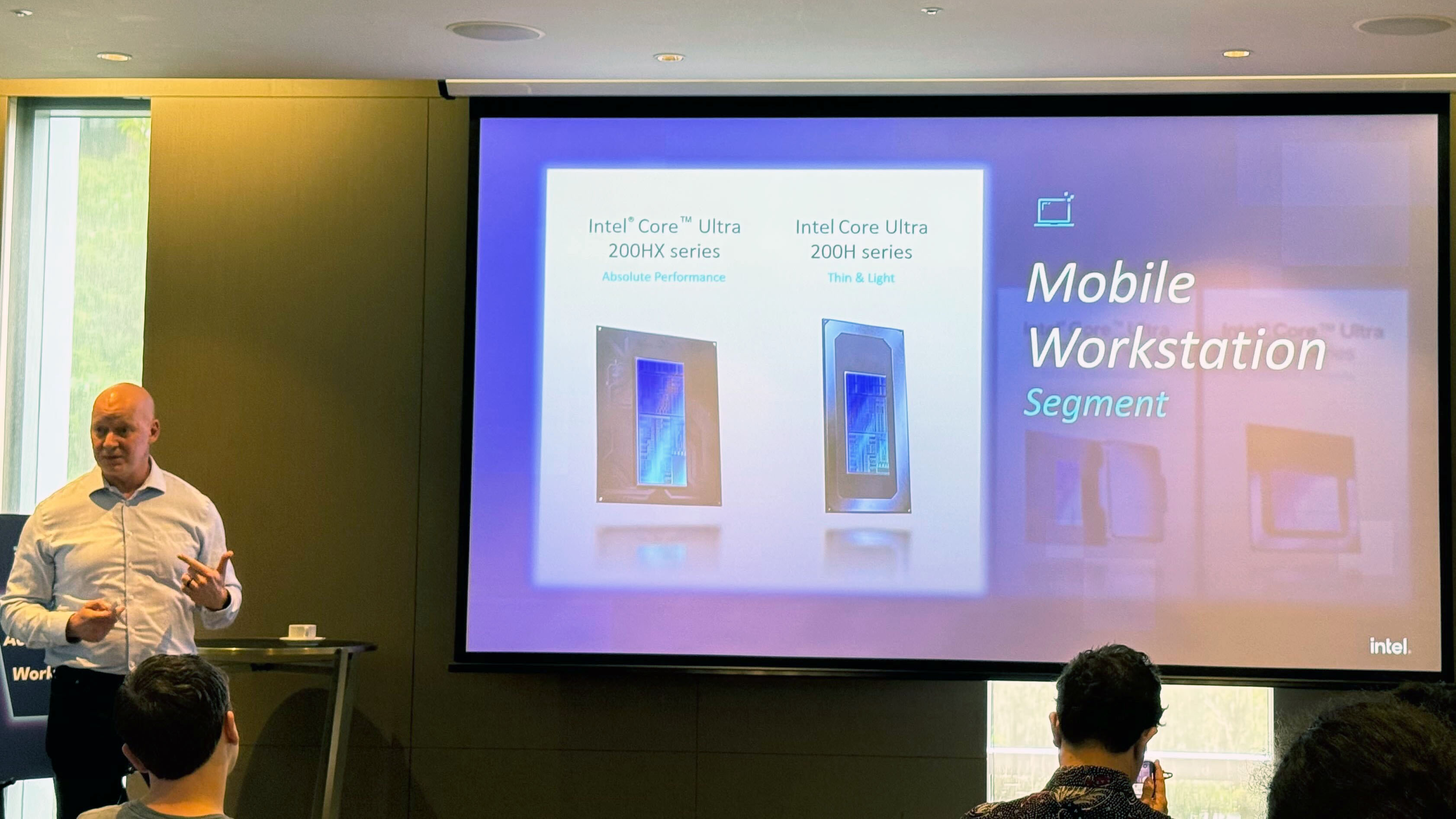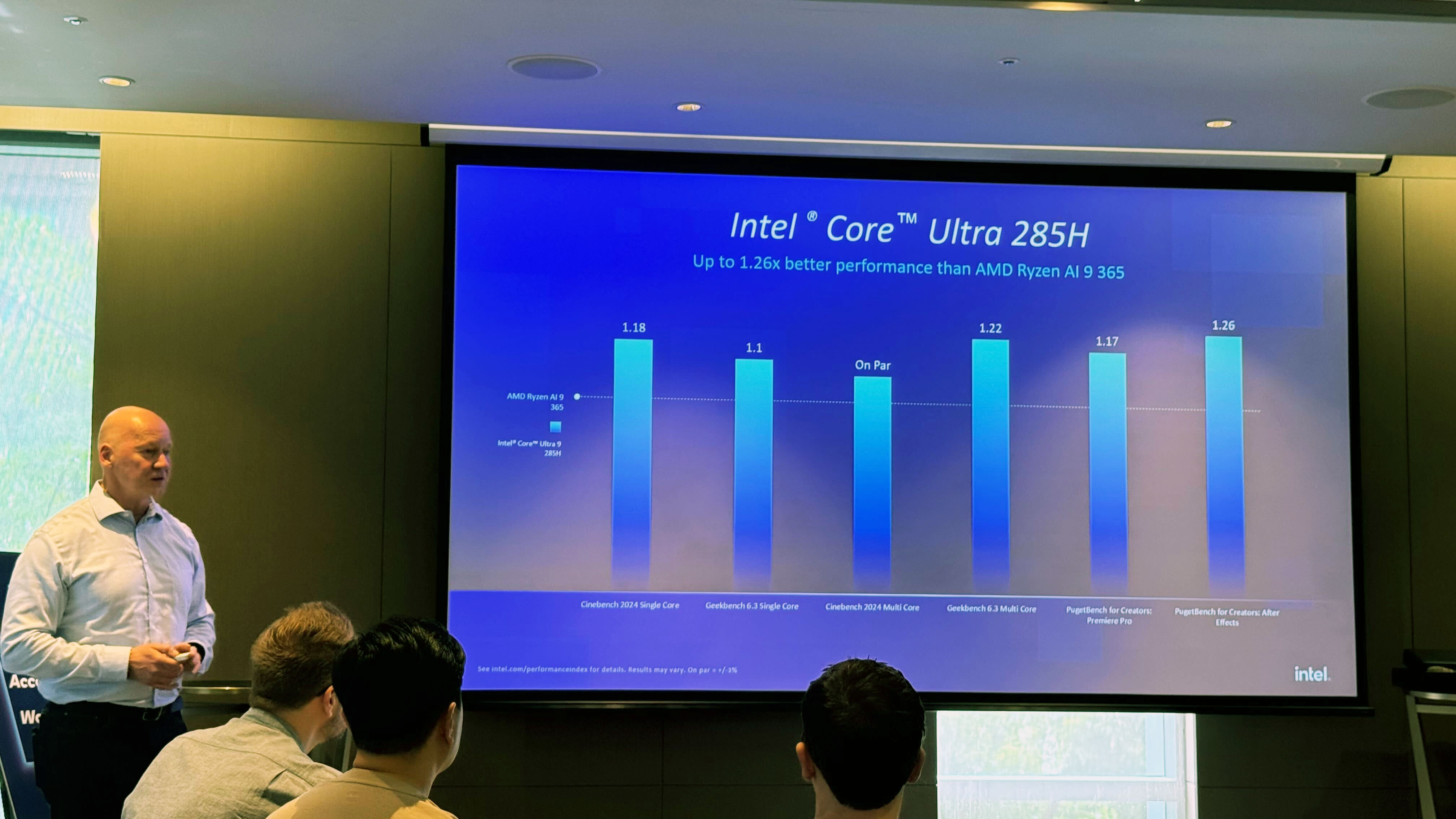Intel isn’t working on discrete GPUs for laptops: Here’s why.
Amid an entry-level workstation "renaissance," Intel doesn't appear to be developing discrete laptop GPUs, relying on Core Ultra 200H's integrated graphics instead.

Intel’s Arc GPU platform has finally taken off on desktop, at least in the budget and mid-range markets.
With the launch of the Arc Pro B50 and B60 workstation graphics cards at Computex last week, Intel's second generation of Arc GPUs is has officially arrived.
But there’s one massive market that still isn’t served by the Arc platform. And that’s laptops.
Sure, Intel has brought its B-series GPUs (codename: "Battlemage") to its integrated graphics tiles on the Core Ultra 200 series chipsets, but integrated GPUs can only take you so far when gaming, rendering designs in 3D, or parsing massive data sets.
So, why are there no Arc GPUs for laptops up for individual sale?
Intel is positioning those Intel Core Ultra 200H systems with integrated Arc 130-140T graphics units as "thin-and-light workstations" — essentially, entry-level workstations.
Intel's Roger Chandler told Laptop Mag at Computex, "probably a good 60% of the market are mobile workstations."
So, these entry-level workstations with integrated graphics are a huge focus for Intel.
Sign up to receive The Snapshot, a free special dispatch from Laptop Mag, in your inbox.
"There's the [Core Ultra 200H] class platform for the thin and light [workstation], and that's where you have the really bigger built-in graphics, where we're seeing some surprise [from customers].
"It surprised a lot of people how [good] the performance is. It's literally more performance than a lot of [entry-level] discrete graphics."
OK — but how does Intel's integrated GPU really stack up against the iGPU competition?
Intel's iGPUs are best-in-class right now

Intel has stiff competition on the integrated graphics front.
AMD's Ryzen AI 300 series also has a powerful integrated graphics tile, but as far as raw computing power goes, Intel's integrated Arc chips on the Intel Core Ultra 200H and Intel Core Ultra 200V chipsets outperform AMD's Ryzen AI 9 HX 370.
However, AMD regains its performance lead with the Ryzen AI Max platform, which can use up to 97GB of system memory as VRAM. (AMD's Strix Halo is in a class of its own as far as x86 architecture goes.)
For traditional integrated GPUs, Intel isn't wrong to consider its Core Ultra 200H systems as capable of some workstation tasks and gaming, particularly if you're not doing a lot of heavy lifting. Gaming on medium settings at 1080p is entirely feasible, but it isn't the performance we expect from a gaming laptop.
On their own, Core Ultra 200H systems result in something of an entry-level device. Intel and its manufacturing partners still leverage the Core Ultra 200HX CPU alongside discrete Nvidia GPUs for high-end mobile workstations and gaming rigs.
But Intel's Chandler tells Laptop Mag that the company isn't seeing entry-level workstations doing the demanding work of traditional workstations anyway. He says users are using them for better productivity.
"When I have a mobile workstation, I never have to close anything."
Intel's Roger Chandler at Computex 2025
Chandler explains it this way: "I use a mobile workstation for my daily driver now, and it's like I'm not using [3D design software application] SolidWorks all day.
"But I'm one of those people who is a tab hoarder. I'll keep 78 tabs open on Chrome, and I've got 14 spreadsheets, and it's like, it started bogging down my old system.
"When I have a mobile workstation, I never have to close anything."
Chandler also says AI will improve performance as well.
"[AI] takes some of the sharp edges off some of these difficult workloads, which means they're more accessible."
All of which is to say, you can get away with just an integrated GPU instead of a more powerful discrete graphics card for a lot of tasks that were considered "workstation-class" just a few years ago.
"Workstations are this whole category of product that is kind of entering this Renaissance," Chandler says.
The Laptop POV: Expanding to discrete mobile graphics cards would still be a good idea for Intel

While it's too late in the Intel Arc B-series to expect a mobile variant, we expect Intel to launch its C-series graphics cards (codenamed "Celestial") later this year or early next year.
But there is still hope for future generations of Arc GPUs to hit the mobile side.
When asked during a press briefing about why Intel hadn't expanded the full Arc discrete GPU platform to laptops yet, Intel rep Qi Lin responded, "that's something we need to continue to work on."
There are already rumors that Nvidia's next generation of graphics cards won't be optimized for gaming, as the company pivots harder toward AI and data center applications of its GPUs. While that's just speculation, the rocky launch of the RTX 50-series does lend some credence to the idea that there will be fewer and fewer Nvidia GeForce cards available in future generations.
Which leaves the laptop GPU market wide open.
After all, for the last several years, basically every gaming laptop and mobile workstation has featured a discrete Nvidia GPU.
AMD hasn't produced a mobile discrete GPU since the Radeon RX 7000 series in early 2023. While AMD could be working on a Radeon 9000 series GPU for laptops, we haven't heard even the glimmer of a rumor around a new laptop GPU from Team Red.
So if Intel can expand the Arc discrete graphics platform to laptops in the next few years, we could see a major upset in the laptop market. But only time will tell.
More from Laptop Mag

A former lab gremlin for Tom's Guide, Laptop Mag, Tom's Hardware, and TechRadar; Madeline has escaped the labs to join Laptop Mag as a Staff Writer. With over a decade of experience writing about tech and gaming, she may actually know a thing or two. Sometimes. When she isn't writing about the latest laptops and AI software, Madeline likes to throw herself into the ocean as a PADI scuba diving instructor and underwater photography enthusiast.
You must confirm your public display name before commenting
Please logout and then login again, you will then be prompted to enter your display name.
